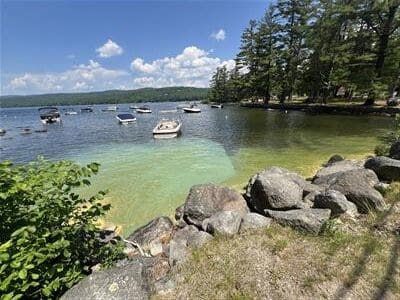NHDES Cyanobacteria Warning for Pleasant Lake

Mooring Area in Elkins
Harmful algal blooms (HABs) have been observed in at least two locations in Pleasant Lake, including Elkins Beach, in the last couple of days. HABs are a potentially serious threat to pets and humans upon contact or drinking the water; dogs have died from exposure to, and from drinking water where there are HABs. The toxins can cause dermatitis and in more severe cases liver and brain damage to people.
See the warning below issued by the state DES, and be extra cautious about you or your pets contacting the water in the areas of these algae blooms. Note that these blooms may be more widespread than the limited sampling indicates.
For those of you unfamiliar with metric volumes, a mL is about one fifth of a teaspoon, so there are close to 10,000,000 HAB cells per teaspoon in the samples taken – this is a very high level.
FROM THE NHDES FAQ LINK BELOW
Is it safe to go in the water during a warning or an alert?
NHDES recommends staying out of the water in any part of a waterbody when a cyanobacteria warning is posted, though we do not close waterbodies. This includes swimming, wading and any activity that may result in direct contact with the water. NHDES also recommends against using the water for drinking even when boiled or filtered, dish washing, bathing and other household uses when a warning is in place. Children and pets are particularly vulnerable to cyanotoxins.
If you choose to recreate during a warning, know that you are at risk of exposure to cyanotoxins. If there are enough cyanobacteria in a waterbody to cause a warning, then there is the potential for negative health effects for you, your children and your pets. If you do choose to recreate during a warning, the risk is highest in areas with visible cloudiness, flecks or colored scum, and lower where the water looks clear. Remember that bloom conditions can change rapidly.
If there is an alert, we suggest taking extra care to visually evaluate the water prior to recreating. Stay out if you see something suspicious and report it.
NHDES encourages everyone to assess their risk before swimming or letting children and pets play in the water, regardless of cyanobacteria warning or alert status.
— — — — — — — — — — — —
Warning for Pleasant Lake Issued by NHDES today
A cyanobacteria warning has been issued at your lake, please see below for details.
Waterbody: Pleasant Lake, New London
Status: WARNING (ADVISORY)
Issued: 6/19/2024
Bloom Description (picture attached): Green material gathering densely along shoreline. Often mixed with pollen and appearing blue as well as green in some areas.
Cyanobacteria Taxa: Dolichospermum
Cyanobacteria Density (cells/mL): 1,940,000
Notes: Bloom was observed and sampled on 6/17 and an alert was issued that day. Several areas were sampled again on 6/18 and both had high cyanobacteria counts so the alert is being changed to a warning.
Warnings are issued when cell counts exceed 70,000 cells/mL. NHDES advises lake users to not wade or swim in the water during a warning. Please also keep pets and livestock out. The warning is not based on a toxin evaluation and is intended as a precautionary measure for short term exposure. Please see our newly updated FAQs for more information.
NHDES will resample in a week. I will reach out to you before then for updates. If you have information on where accumulated material is being observed at that time, please let us know to guide our sampling efforts. Warnings remain active until the bloom subsides. You can also see warning details on the Health Swimming Mapper.
To the health officer or other official responsible for posting signs, please post our red cyanobacteria warning signs at all public access points. Please let me know if you do not have any to post or if you need replacements.
Please forward this email to other residents / community members who need this information. If they would like to be added to the email distribution list, please have them sign up to be directly included on future communications from NHDES. If you prefer to no longer receive these sampling updates, simply respond, and indicate “unsubscribe”.Best,
Kate Hastings and the CyanoHAB Team
Cyanobacteria Harmful Algal Bloom Program
Watershed Management Bureau, Water Division
New Hampshire Department of Environmental Services
29 Hazen Drive, P.O. Box 95, Concord, NH 03302-0095
603-848-8094 hab@des.nh.gov
